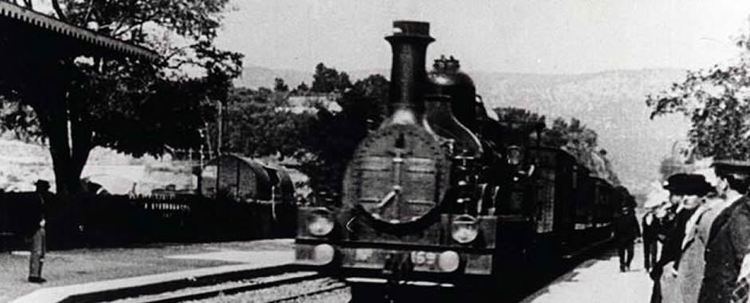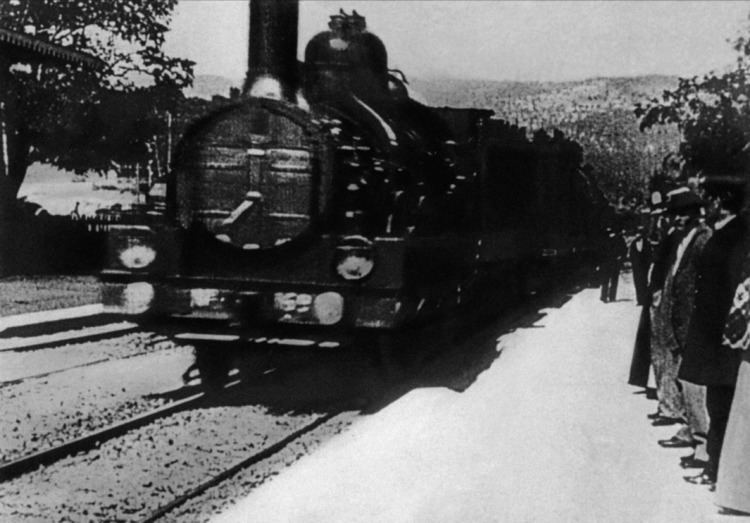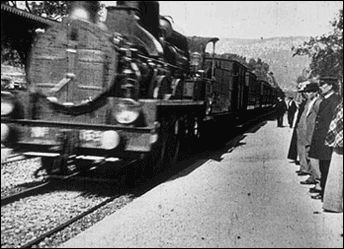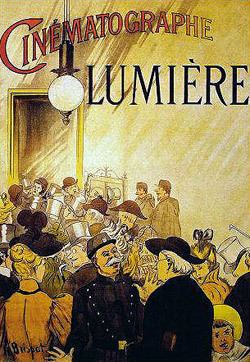Productioncompany Société Lumière Running time 50 seconds | Distributed by Société Lumière Initial release 1895 | |
 | ||
Directed by Auguste LumièreLouis Lumière Produced by Auguste LumièreLouis Lumière Release date 25 January 1896 (1896-01-25) Directors Auguste Lumière, Louis Lumière Producers Auguste Lumière, Louis Lumière Cinematography Auguste Lumière, Louis Lumière Similar Employees Leaving the Lumiè, Tables Turned on the Garde, Le Repas, A Trip to the Moon, The Photographical Congress | ||
L arriv e d un train en gare de la ciotat 1895
L'arrivée d'un train en gare de La Ciotat (translated from French into English as The Arrival of a Train at La Ciotat Station, Arrival of a Train at La Ciotat (US) and The Arrival of the Mail Train, and in the United Kingdom the film is known as Train Pulling into a Station) is an 1895 French short black-and-white silent documentary film directed and produced by Auguste and Louis Lumière. Contrary to myth, it was not shown at the Lumières' first public film screening on 28 December 1895 in Paris, France: the programme of ten films shown that day makes no mention of it. Its first public showing took place in January 1896.
Contents
- L arriv e d un train en gare de la ciotat 1895
- Content
- Production
- Contemporary reaction
- 3D version
- Current status
- References

Content

This 50-second silent film shows the entry of a train pulled by a steam locomotive into a train station in the French coastal town of La Ciotat. Like most of the early Lumière films, L'arrivée d'un train en gare de La Ciotat consists of a single, unedited view illustrating an aspect of everyday life. There is no apparent intentional camera movement, and the film consists of one continuous real-time shot.
Production

This 50-second movie was filmed in La Ciotat, Bouches-du-Rhône, France. It was filmed by means of the Cinématographe, an all-in-one camera, which also serves as a printer and film projector. As with all early Lumière movies, this film was made in a 35 mm format with an aspect ratio of 1.33:1.
Contemporary reaction
The film is associated with an urban legend well-known in the world of cinema. The story goes that when the film was first shown, the audience was so overwhelmed by the moving image of a life-sized train coming directly at them that people screamed and ran to the back of the room. Hellmuth Karasek in the German magazine Der Spiegel wrote that the film "had a particularly lasting impact; yes, it caused fear, terror, even panic." However, some have doubted the veracity of this incident such as film scholar and historian Martin Loiperdinger in his essay, "Lumiere's Arrival of the Train: Cinema's Founding Myth". Others such as theorist Benjamin H. Bratton have speculated that the alleged reaction may have been caused by the projection being mistaken for a camera obscura by the audience which at the time would have been the only other technique to produce a naturalistic moving image. Whether or not it actually happened, the film undoubtedly astonished people unaccustomed to the illusion created by moving images. The Lumière brothers clearly knew that the effect would be dramatic if they placed the camera on the platform very close to the arriving train. Another significant aspect of the film is that it illustrates the use of the long shot to establish the setting of the film, followed by a medium shot, and close-up. (As the camera is static for the entire film, the effect of these various "shots" is achieved by the movement of the subject alone.) The train arrives from a distant point and bears down on the viewer, finally crossing the lower edge of the screen.
3D version

What most film histories leave out is that the Lumière Brothers were trying to achieve a 3D image even prior to this first-ever public exhibition of motion pictures. Louis Lumière eventually re-shot L’Arrivée d’un Train with a stereoscopic film camera and exhibited it (along with a series of other 3D shorts) at a 1935 meeting of the French Academy of Science. Given the contradictory accounts that plague early cinema and pre-cinema accounts, it's plausible that early cinema historians conflated the audience reactions at these separate screenings of L’Arrivée d’un Train. The intense audience reaction fits better with the latter exhibition, when the train apparently was actually coming out of the screen at the audience. But due to the fact that the 3D film never took off commercially as the conventional 2D version did, including such details would not make for a compelling myth.
Current status

The short has been featured in a number of film collections including Landmarks of Early Film volume 1. A screening of the film was depicted in the 2011 film Hugo. The scene of the train pulling in was placed at #100 on Channel 4's two-part documentary The 100 Greatest Scary Moments.
In March 2017, the film was encoded into DNA by Yaniv Erlich and Dina Zielinski.
